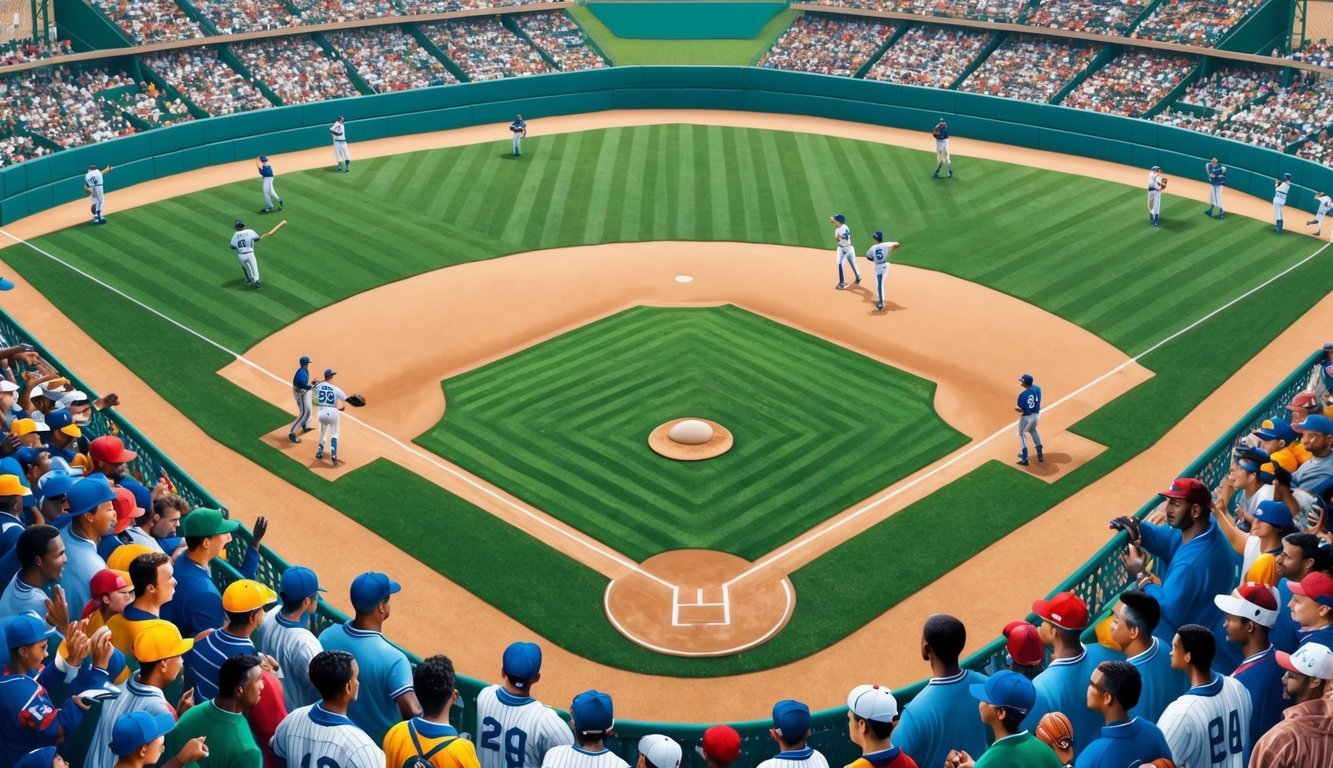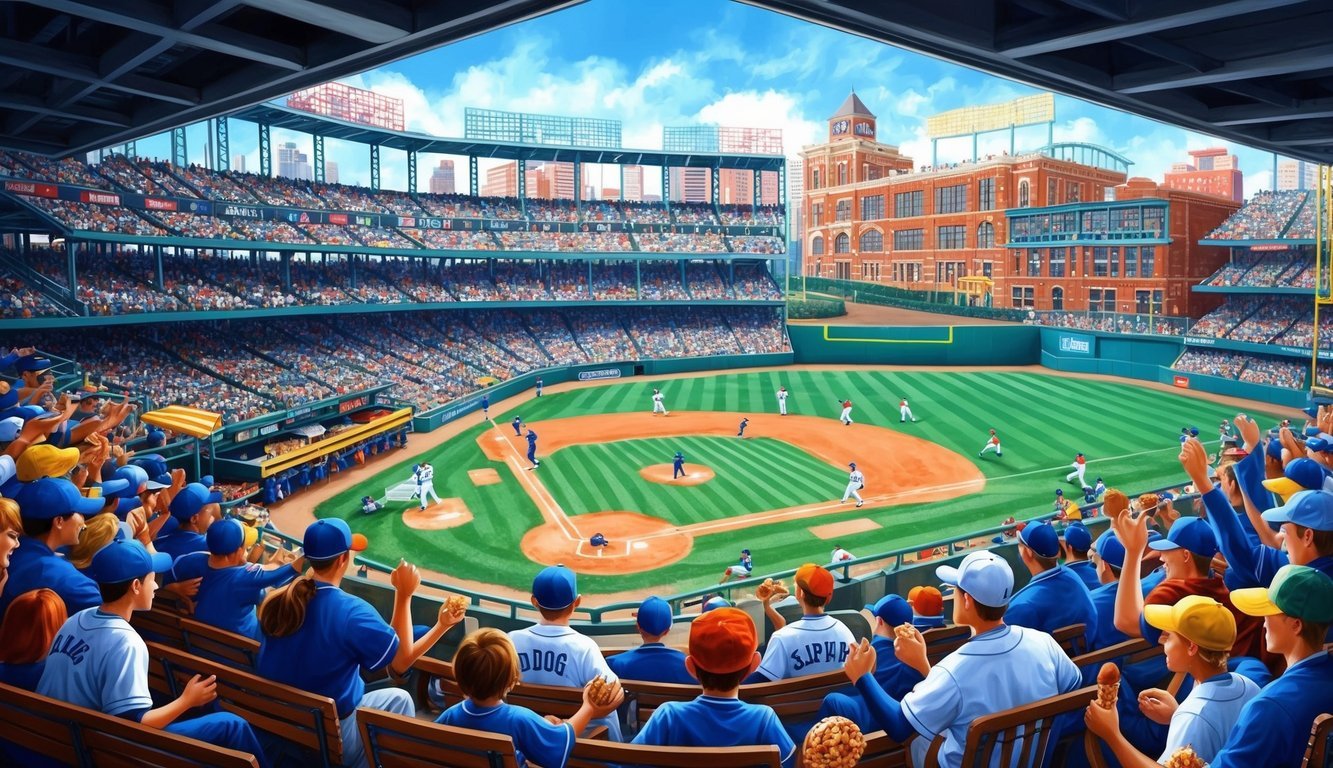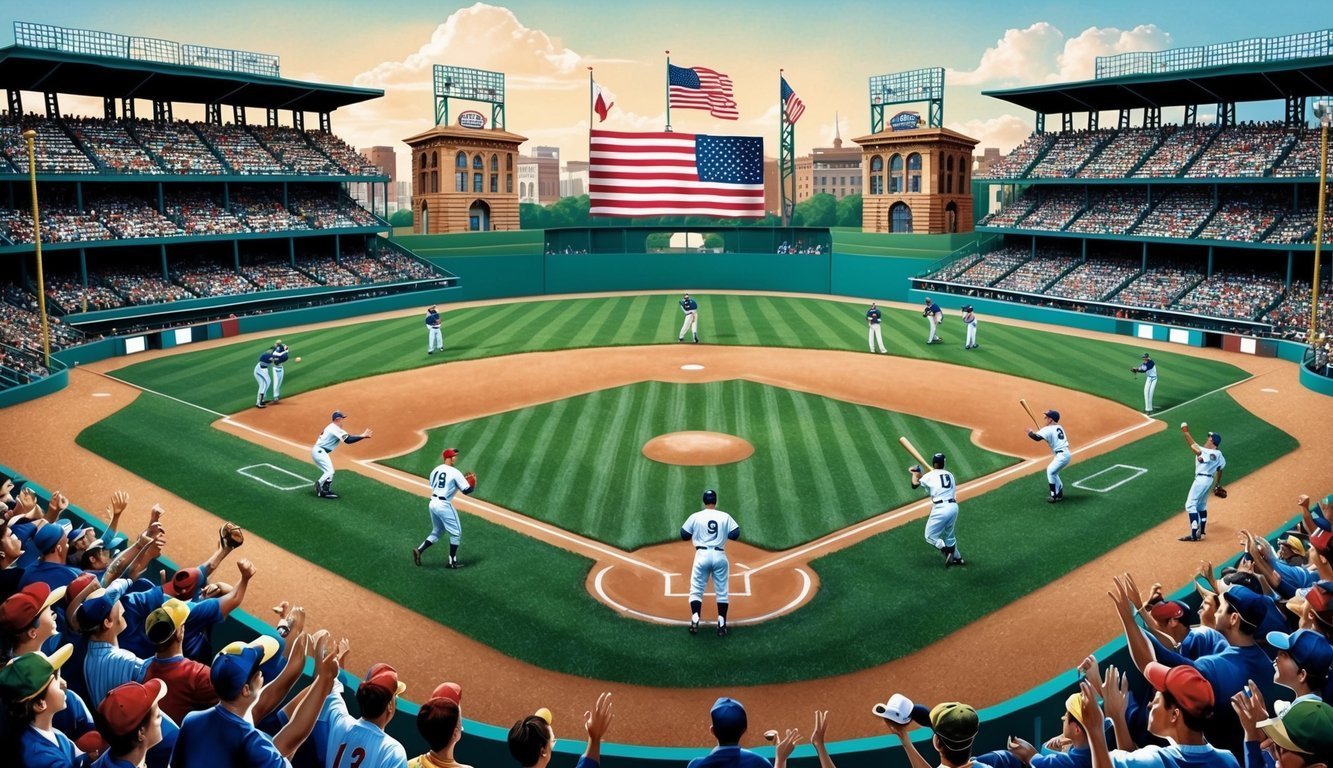Baseball has woven itself into the fabric of American culture since the mid-19th century.
The sport’s origins can be traced back to informal games played by boys and amateur enthusiasts using homemade equipment.
As baseball’s popularity grew, it evolved from a casual pastime to America’s national sport, reflecting the country’s values and history along the way.
The formation of amateur men’s clubs in the 1830s-1850s laid the groundwork for the game’s expansion.
This led to the emergence of semi-professional teams in the 1860s and eventually the establishment of professional leagues.
The National League, founded in 1876, became one of baseball’s enduring institutions and helped shape the modern era of the sport.
Baseball’s journey mirrors America’s own story, from the Civil War to the Civil Rights movement and beyond.
The sport has produced legendary figures like Babe Ruth, Jackie Robinson, and Hank Aaron, whose impact extended far beyond the diamond.
Through its rich history, baseball continues to captivate fans and serve as a lens through which to view American society.
The Early Years and Evolution of the Game
Baseball’s journey from informal bat-and-ball games to America’s national pastime is a fascinating tale of innovation and organization.
The sport’s development in the 19th century laid the foundation for the modern game we know today.
From Rounders to Baseball
Baseball evolved from earlier English games like rounders.
In the mid-1800s, Alexander Cartwright played a crucial role in shaping the sport.
He formalized rules that distinguished baseball from its predecessors.
Cartwright’s New York Knickerbockers established key elements of the game.
They introduced the diamond-shaped infield and set the bases 90 feet apart.
These changes helped create a more structured and exciting sport.
The myth of Abner Doubleday inventing baseball in 1839 has been debunked.
Instead, baseball developed gradually over time, with many contributors refining its rules and gameplay.
19th Century Growth
Baseball’s popularity exploded in the 1850s and 1860s.
Amateur clubs formed across the country, playing by various local rules.
The Civil War helped spread the game as soldiers from different regions shared their versions.
In 1857, the National Association of Base Ball Players was founded.
This organization worked to standardize rules and promote the sport.
It marked an important step towards organized baseball.
As the game grew, so did the equipment.
Early baseballs were handmade and varied in size and composition.
By the 1870s, manufacturers began producing standardized balls, improving consistency in play.
Formation of the National League
The National League, founded in 1876, marked the beginning of professional baseball as we know it.
It brought together the top teams from major cities and established a uniform set of rules.
Key figures like William Hulbert and Albert Spalding played crucial roles in the league’s formation.
They sought to create a more stable and reputable organization than previous attempts at professional leagues.
The National League introduced several innovations.
These included a set schedule, player contracts, and a championship series.
These changes helped baseball become a true spectator sport.
Establishment of the American League
The American League emerged in 1901 as a rival to the National League.
Founded by Ban Johnson, it quickly gained popularity by placing teams in underserved cities.
The new league introduced the designated hitter rule in 1973, creating a notable difference between the two leagues.
This rule allowed for a player to bat in place of the pitcher.
Competition between the leagues led to the first World Series in 1903.
This annual championship series became a hallmark of the sport, crowning the best team in baseball each year.
The American League’s success forced cooperation with the National League.
Together, they formed Major League Baseball, setting the stage for the modern era of the sport.
Major Milestones and Figures
Baseball’s history is marked by legendary players who changed the game forever.
These icons set records, broke barriers, and inspired generations of fans and athletes alike.
Babe Ruth and the Rise of the Slugger
Babe Ruth transformed baseball in the 1920s.
His powerful hitting style revolutionized the sport, ushering in the “live-ball era.” Ruth’s incredible 714 career home runs stood as a record for decades.
The Bambino’s larger-than-life personality made him America’s first sports superstar.
His impact extended beyond the field, drawing massive crowds and boosting baseball’s popularity nationwide.
Ruth’s legacy lives on in Cooperstown’s National Baseball Hall of Fame.
He was part of the inaugural class inducted in 1936, cementing his status as one of the game’s all-time greats.
Breaking Barriers: Jackie Robinson
Jackie Robinson made history on April 15, 1947, when he stepped onto Ebbets Field as a Brooklyn Dodger.
He became the first African American to play in Major League Baseball in the modern era.
Robinson’s courage in the face of intense racism and discrimination paved the way for integration in baseball.
His success on the field – winning Rookie of the Year and later the National League MVP – proved that talent knows no color.
Robinson’s impact reached far beyond baseball.
He became a key figure in the Civil Rights movement, using his platform to advocate for equality and justice.
Record Setters: Hank Aaron and Beyond
Hank Aaron’s pursuit of Babe Ruth’s home run record captivated the nation in 1974.
Despite facing racial threats, Aaron persevered.
On April 8, he hit his 715th home run, surpassing Ruth’s mark.
Aaron finished his career with 755 home runs, a record that stood until 2007.
His consistent excellence over 23 seasons earned him a place among baseball’s greatest players.
Other notable record-setters include:
- Pete Rose: All-time hits leader (4,256)
- Cal Ripken Jr.: Most consecutive games played (2,632)
- Nolan Ryan: Career strikeouts (5,714)
These players’ achievements have set the standard for excellence in America’s pastime.
Expansion of Influence and Diversity

Baseball’s reach grew beyond its initial boundaries, embracing diverse communities and spreading globally.
This expansion brought new talent, perspectives, and cultural influences to America’s pastime.
Leagues around the world adopted the sport, fostering new generations of skilled players who brought fresh strategies and techniques.
Savvy team executives began exchanging insights, with some even uncovering baseball GM secrets that gave their franchises a competitive edge.
As analytics and scouting evolved, the game transformed, blending tradition with innovation on an international stage.
Negro Leagues and Integration
The Negro Leagues showcased exceptional African American talent during segregation.
Stars like Satchel Paige and Josh Gibson dazzled fans with their skills.
In 1947, Jackie Robinson broke the color barrier in Major League Baseball, paving the way for integration.
Branch Rickey, the Brooklyn Dodgers’ general manager, signed Robinson.
This bold move changed baseball forever.
Other teams soon followed suit, signing talented Black players from the Negro Leagues.
Integration wasn’t smooth, but it enriched the game.
Players like Hank Aaron and Willie Mays became baseball icons, inspiring future generations.
Global Growth: Latin America and Asia
Baseball’s popularity surged in Latin America and parts of Asia.
Cuban players made early impacts in the Major Leagues.
Roberto Clemente from Puerto Rico became a legend both on and off the field.
After World War II, baseball took root in Japan.
The sport flourished there, developing its own unique style and producing MLB stars like Ichiro Suzuki.
Latin American countries like the Dominican Republic and Venezuela became baseball powerhouses.
They’ve produced numerous MLB stars and built strong national teams.
Women in Baseball: A League of Their Own
During World War II, the All-American Girls Professional Baseball League emerged.
It kept baseball alive while many male players were serving in the military.
The league ran from 1943 to 1954, featuring skilled female athletes.
Players like Dorothy Kamenshek and Sophie Kurys became fan favorites.
While the AAGPBL didn’t last, it proved women could play professional baseball.
It inspired future generations of female athletes and was immortalized in the film “A League of Their Own.”
Women continue to make strides in baseball.
Some have played in men’s minor leagues, while others coach or work in front offices.
The Business and Culture of Baseball

Baseball’s influence extends far beyond the diamond, shaping America’s economic and social landscape.
The sport’s business practices, labor relations, and cultural impact have evolved significantly over time.
Major Leagues and the Economy of Sport
Major League Baseball (MLB) generates billions in revenue annually.
Ticket sales, merchandise, and lucrative TV contracts contribute to the sport’s economic power.
Teams like the New York Yankees and Los Angeles Dodgers are valued at over $3 billion each.
Stadiums have become economic engines for cities.
New ballparks often spark neighborhood revitalization and boost local businesses.
The MLB All-Star Game can inject $60-100 million into a host city’s economy.
Baseball’s financial reach extends to minor leagues and amateur levels.
College baseball programs and youth leagues create jobs and drive equipment sales nationwide.
Baseball Management and Labor Relations
The relationship between players and owners has been tumultuous.
The reserve clause, which bound players to teams indefinitely, was a major point of contention until its abolition in 1975.
Key figures like Kenesaw Mountain Landis, MLB’s first commissioner, shaped the sport’s governance.
Landis cleaned up gambling scandals but also enforced racial segregation in the league.
Players unionized in 1966, leading to improved wages and working conditions.
Collective bargaining agreements now cover issues like free agency, salary arbitration, and revenue sharing.
Baseball in American Society and Media
Baseball’s cultural impact is immeasurable.
The sport has been a catalyst for social change, exemplified by Jackie Robinson breaking the color barrier in 1947.
Media coverage has transformed baseball’s place in society.
Radio broadcasts in the 1920s expanded fanbases, while television deals now bring games to millions of homes.
Baseball permeates popular culture through movies, books, and music.
Films like “Field of Dreams” and “A League of Their Own” celebrate the sport’s mythology and history.
Fan engagement has evolved with technology.
Fantasy leagues, social media, and advanced statistics have created new ways for fans to connect with the game.
Era-Specific Developments and Changes

Baseball has undergone significant transformations throughout its history.
The game’s evolution spans distinct eras, each marked by unique characteristics and changes that shaped America’s pastime.
Dead-Ball to Live-Ball Era
The Dead-Ball Era, from the 1900s to 1920, saw low-scoring games dominated by pitching and defense.
Balls were used until they fell apart, making them difficult to hit.
Spitballs and other pitch doctoring were legal, giving pitchers an edge.
In 1920, the Live-Ball Era began.
New rules banned altered pitches and required fresh baseballs.
Babe Ruth’s power hitting revolutionized the game, ushering in an offensive explosion.
Home runs became more common, and batting averages soared.
This era also saw the first radio broadcast of the World Series in 1921, expanding baseball’s reach to millions of fans across the country.
Post-War and Expansion Eras
After World War II, baseball entered a golden age.
The color barrier was broken in 1947 when Jackie Robinson joined the Brooklyn Dodgers.
This historic moment paved the way for integration and brought immense talent to the Major Leagues.
The 1950s and 1960s saw rapid expansion.
New teams like the New York Mets and Houston Colt .45s (later Astros) joined the leagues.
The first West Coast teams emerged with the Dodgers and Giants moving to California in 1958.
In 1962, the National Baseball Hall of Fame and Museum opened in Cooperstown, New York, preserving the game’s rich history.
Modern Era Developments
The Modern Era brought significant changes to baseball.
In 1975, free agency was introduced.
It gave players more control over their careers and led to skyrocketing salaries.
In 1973, the American League adopted the designated hitter rule.
This rule fundamentally altered strategy and player roles.
Technological advancements transformed the game.
In 2008, instant replay for certain calls was implemented.
It enhanced accuracy in officiating.
The steroid era of the 1990s and early 2000s led to record-breaking performances but also controversy.
Later, stricter drug testing policies were implemented to maintain the integrity of the game.
